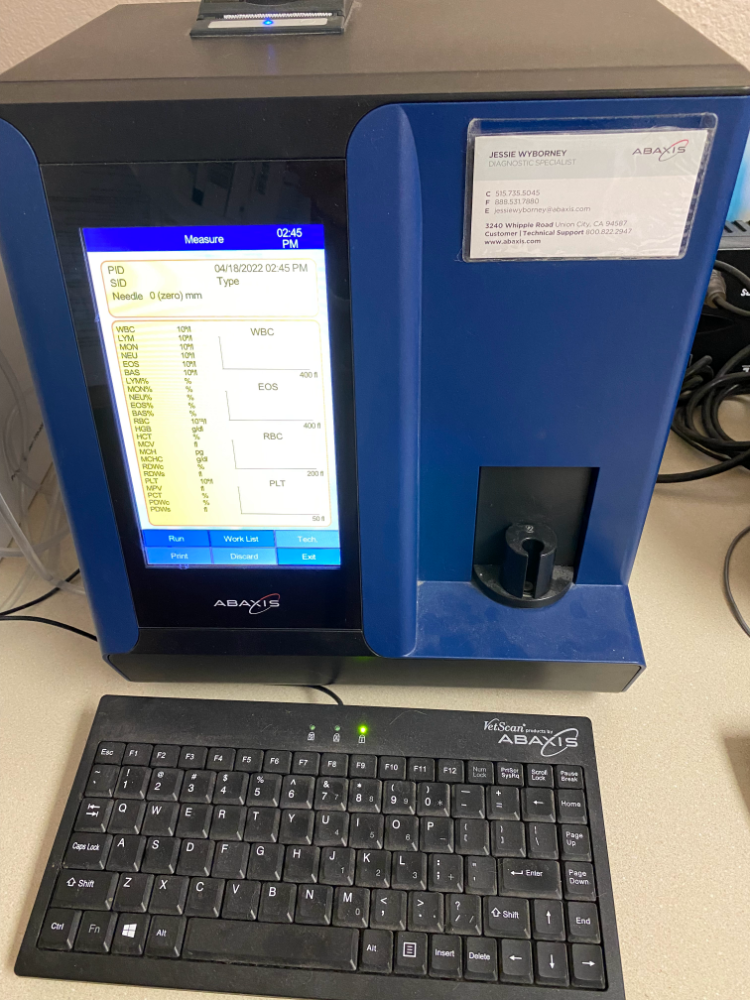Many times our patients are needing us to check blood work. The CBC is an important diagnostic test used to evaluate the blood more closely. I wanted to talk this month about a machine that allows us to run CBC laboratory tests right in the clinic and what those values mean. This photo shows the machine we use to run a Complete Blood Count (CBC). This is a standard test used prior to surgical procedures, during wellness checks, and when we have concerns for illness. The machine takes a sample of blood and sorts out the cells into three different components. We have the White Blood Cell (WBC) count, the Red Blood Cell (RBC), and the Platelet (PLT) Count. All three share different information about components of the blood.
WBC are made up of 5 different cellular structures. Each of these cell types when counted by this machine make up the WBC. The neutrophils (51-72%) usually are the largest percentage of WBC cells, followed by the lymphocytes (8-35%), monocytes (1-9%), eosinophils 0-9%), and basophils (0-2%). When these numbers are elevated it will raise the WBC count. We then look for the cell causing the elevation. If the neutrophils are up we know that there is an active infection present somewhere in the body. If the eosinophils are elevated we look for evidence of inflammation caused by allergies or parasites. Sometimes these levels can be lower than normal and we would look for viral infections or concerns with the bone marrow itself. Lymphocytes help develop antibodies to protect against future attacks by the same organism.
RBC are made up of different components that all help our body carry oxygen throughout the body. High RBC counts can most commonly indicate dehydration. Anemia is when our RBC is low. We can have low counts related to blood loss from active bleeding, destruction of red blood cells from diseases, bone marrow or other diseases that prevent production of red blood cells. Hemoglobin (HGB) binds and releases the oxygen to carry it to all our cells. The HGB will be directly affected by the red blood cell count at times of dehydration or anemia. Hematocrit (HCT) and Pack Cell Volume (PCV) mean the same thing. This is the percentage of red blood cells circulating in the blood. If we spin the blood the red blood cells will settle to the bottom and the serum will be the liquid at the top. This percentage can give us information to help figure out what disease process may be causing an increase or a decrease in the RBC. MCV, MCH, and MCHC are also values used within the RBC. They each play a part in the diagnosis of anemia or iron levels within the body.
Platelets (PLT) are responsible for helping to clot our blood. When we get a cut or a scratch the platelets become sticky and gather in large numbers to seal the leak in our blood vessel. This is extremely important to know prior to a surgical procedure. If a pet has low platelets that could affect the amount of bleeding at the time of surgery.
There are conditions that have an effect on each of these values and even some that can cause changes in all three. We take into consideration this CBC each and every time we do surgeries or are faced with health concerns of our patients. We ask if you are wanting to do a pre- surgical blood screen prior to anesthesia procedures or if your pet has presented with an illness that needs laboratory work to help diagnose what is ailing them. We also require doing this test annually if your pet is on long term medications. The CBC is one of those tests that we run right in our lab and can have results quickly.
Next time you bring your pet into the clinic you will know why the CBC is an important piece of information that can help us get your furry friends back home quickly and safely. Happy Spring and hope the April showers are bringing in your May flowers!

